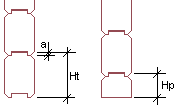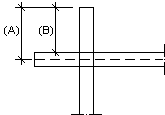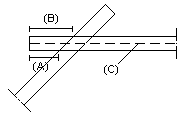Define the structure of the log wall to be added by setting the wall parameters in the dialog box.
Select the log wall parameters on the first tab of the dialog box.
Log profile
Select the log profile from the list. The list consists of the cross sections in the LOG profile library. The profile label usually indicates the log type (planed or round) that has been defined for the cross section. Either of the radio buttons Planed log or Round log is automatically updated according to the log type of the selected profile.
Log wall / Log beam
Define how the wall to be added is connected to the crossing wall by selecting one of the following radio buttons:
Normal log wall - Cribbing to joint
Log beam (notches) - Cribbing to joint
Laminated beam - Hole to crossing wall
Log beam (hole) - Hole to crossing wall
Wall base height
Type the height of the bottom of the log wall in relation to the floor base height. The height of the bottom of the log wall = the height of the lowest point of the bottom log. The default height position is read from the project parameters.
Siding Top Height
Type the height of the log wall. You can type the height either in millimeters or multiples of log courses, for example 15H, where H = height of one log course. The height of a log wall is the distance between the lowest point of the bottom log and the highest point of the top log. The default height is read from the project parameters.
No depression
If necessary, select the check box No depression.
Top log
Select either of the following as the type of the top log:
Always full - The log wall height is determined by the number of full logs and may be different than the value in the Wall height field.
Partial if necessary - If the log division is uneven, the top log is partial and the height of the log wall is exactly the same as the value in the Wall height field.
You can later change the top log type by using the Set Log Wall Height function.
The parameters of the selected log profile are displayed on the second tab of the dialog box. The parameters are read from the LOG profile library. You can change the values of only the Crib width, Height of bottom log and Height of half log parameters.
Log profile
You can reselect a log profile from the list. The list consists of the cross sections in the LOG profile library.
Log width
The width of the selected log profile.
Log height
The height of the selected log profile.
Log net height
The net height of the selected log profile.
Notch width
The width of the crib is, by default, the same as the width of the log. If necessary, you can type a value for the crib width that is smaller or than larger than the log width. When the field is empty, the default value is used.
Base log height
The height of the bottom log of the wall may be smaller than the normal height of the log profile (the Log height parameter). Type the height in the text field. The parameter is the same as the Full parameter in the wall height data and the log profile library.
Half log height
The bottom log of a wall may be a half log. Type the height of a half log in the text field.
![]() When defining the height of the bottom half
log, take into consideration how you want the risers of crossing
walls to be positioned in relation to each other. If, for example,
you want the riser of the bottom half log to be half of the riser
of the bottom full log, the height of the bottom half log will then
be
When defining the height of the bottom half
log, take into consideration how you want the risers of crossing
walls to be positioned in relation to each other. If, for example,
you want the riser of the bottom half log to be half of the riser
of the bottom full log, the height of the bottom half log will then
be
Hp = (Ht - a)/2 + a
where
Hp = height of the bottom half log
Ht = height of the lowest full log
a = the settling space part of the log profile

Lumber width
The width of the log billet.
Lumber height
The height of the log billet.
Corner length
The default corner length is the one defined in the profile library. If necessary, type a new length in the field. Select a line for the wall from which the corner overlap will be measured:
From middle line - Measure from the center line of the wall (A).
From edge line - Measure from the exterior surface of the wall (B).

Corner mode
Select the edge that determines the corner overlap in an oblique corner. The default edge is the one defined in the profile library. Select one of the following as the measuring method:
Shorter side (A)
Longer side (B)
Middle line (C)

![]() Parameters of
Different Floors
Parameters of
Different Floors
![]() Adding a Log Wall
Adding a Log Wall
![]() Editing the Log Cross Section
Library
Editing the Log Cross Section
Library
| Converted from CHM to HTML with chm2web Pro 2.85 (unicode) |